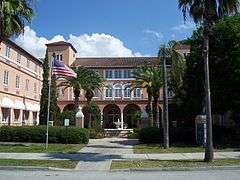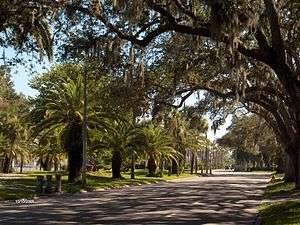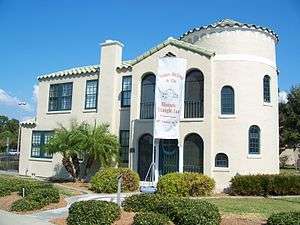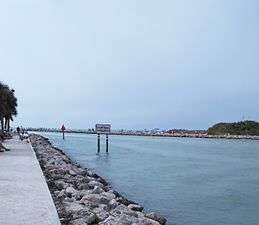Venice, Florida
| Venice, Florida | |
|---|---|
| City | |
| Motto: "City on the Gulf"[1] | |
 Location in Sarasota County and the state of Florida | |
| Coordinates: 27°6′N 82°26′W / 27.100°N 82.433°WCoordinates: 27°6′N 82°26′W / 27.100°N 82.433°W | |
| Country |
|
| State |
|
| County | Sarasota |
| Area | |
| • Total | 16.6 sq mi (43.1 km2) |
| • Land | 15.3 sq mi (39.5 km2) |
| • Water | 1.4 sq mi (3.5 km2) |
| Elevation | 10 ft (3 m) |
| Population (2010) | |
| • Total | 21,253 |
| • Density | 1,359/sq mi (524.7/km2) |
| • Density | 5,656.889/sq mi (2,184.137/km2) |
| Time zone | Eastern (EST) (UTC-5) |
| • Summer (DST) | EDT (UTC-4) |
| ZIP codes | 34284, 34285, 34292, 34293 |
| Area code(s) | 941 |
| FIPS code | 12-73900[2] |
| GNIS feature ID | 0292749[3] |
| Website |
www |


Venice is a city in Sarasota County, Florida, United States. Venice consists of a large section of mainland, as well as Venice Island just off the coast. The city is located south of Nokomis and north of Englewood. As of the 2010 census, the city had a population of 20,748.[4] It is noted for its large snowbird population and was voted as a top 10 Happiest Seaside Towns by Coastal Living.[5]
Venice is a principal city of the Bradenton-Sarasota-Venice, Florida Metropolitan Statistical Area.
History
In the 1870s, Richard Roberts established a homestead near Roberts Bay. In 1884, he sold a portion of his holdings to Frank Higel. Higel established a citrus operation involving the production of several lines of canned citrus items, and for the next 30 years the Higel family members were boat builders, fishermen, grove caretakers and contractors. Darwin Curry was the first postmaster. The Higel and Curry families chose the name "Venice" for their community post office, located south of Shakett Creek on what is now Portia Street in the unincorporated community of Nokomis.
The first railroad to Venice was built in 1911, paving the way for new development and expansion. Development in Venice occurred slowly, and it remained a small fishing town and farming community through the first part of the 1920s. In 1925, Dr. Fred H. Albee, a well-known orthopedic surgeon, purchased 2,916 acres (11.80 km2) of land from the Venice-Sarasota Company. Albee had previously developed Nokomis and built its first luxury hotel, known as the Pollyanna Inn. Albee retained John Nolen, a world-renowned city planner, to design a city on his land. Fred Albee, however, did not have a chance to implement his city plan before he was approached with a proposal from the Brotherhood of Locomotive Engineers to purchase his land in October 1925. The purchase was motivated by a desire by the BLE to increase the union's assets and holdings in the area.[6]
The BLE Realty Corporation was organized to develop the area, and the Venice Company was created to market property. The company retained planner John Nolen to complete a city plan in 1926. The BLE Realty Company selected George A. Fuller as the contractor; the New York architectural firm of Walker & Gillette, as supervising architects; and Prentiss French as landscape architect. Finally on June 10, 1926, the first street in Venice opened to traffic. Nassau Street ran from its terminus at the Tamiami Trail through Venezia Park and again into the Trail. By mid-June 1926, the first phase was complete, with 6 miles (10 km) of graded streets and a mile of 7-foot-wide (2.1 m) sidewalks and gutters. The Hotel Venice (now known as Park Place on Nassau Street) opened on June 21, 1926, and residential construction in the town started in July 1926, with the construction of three large residences in the Gulf View subdivision. That same year, the city of Venice held its first town council meeting and formed the police and fire departments. Florida Governor John W. Martin appointed Edward L. Worthington as the first mayor of Venice. After annexations of surrounding areas, the state legislature changed the designation of Venice from a "town" to "city" on May 9, 1927.[6] Venice was named after Venice, Italy.[7]
The Venice Army Air Base was established in May 1942. The 27th Service Group was relocated from McDill Field in Tampa to provide training for support services to combat air units, and later, the 13th Fighter Squadron, 53rd Fighter Group, was transferred to Venice from Fort Myers. They were operational training units for combat fighter pilots and ground crewmen. After World War II, the city of Venice acquired the air base from the United States government, with the stipulation that it always be used for aviation or revert to federal ownership.[6]
Three of the hijackers in the September 11 attacks, Mohamed Atta, Marwan al-Shehhi, and Ziad Jarrah, took flight training lessons at Huffman Aviation, located at the Venice Municipal Airport.[8]
Geography
Venice is located at 27°6′N 82°26′W / 27.100°N 82.433°W (27.0987, -82.4390).[9]
According to the United States Census Bureau, the city has a total area of 16.6 square miles (43.1 km2), of which 15.3 square miles (39.5 km2) is land and 1.4 square miles (3.5 km2), or 8.19%, is water.[4]
Demographics
| Historical population | |||
|---|---|---|---|
| Census | Pop. | %± | |
| 1930 | 309 | — | |
| 1940 | 507 | 64.1% | |
| 1950 | 727 | 43.4% | |
| 1960 | 3,444 | 373.7% | |
| 1970 | 6,648 | 93.0% | |
| 1980 | 12,153 | 82.8% | |
| 1990 | 16,922 | 39.2% | |
| 2000 | 17,764 | 5.0% | |
| 2010 | 20,748 | 16.8% | |
| Est. 2015 | 22,211 | [10] | 7.1% |
As of the census[2] of 2000, there were 17,764 people, 9,680 households, and 5,362 families residing in the city. The population density was 1,948.8 inhabitants per square mile (752.1/km²). There were 13,516 housing units at an average density of 1,482.8 per square mile (572.2/km²). The racial makeup of the city was 98.14% White, 0.55% African American, 0.14% Native American, 0.41% Asian, 0.03% Pacific Islander, 0.24% from other races, and 0.51% from two or more races. Hispanic or Latino of any race were 1.10% of the population.
There were 9,680 households out of which 7.0% had children under the age of 18 living with them, 49.2% were married couples living together, 4.8% had a female householder with no husband present, and 44.6% were non-families. 40.3% of all households were made up of individuals and 30.3% had someone living alone who was 65 years of age or older. The average household size was 1.76 and the average family size was 2.25.
In the city the population was spread out with 6.9% under the age of 18, 2.3% from 18 to 24, 10.2% from 25 to 44, 23.1% from 45 to 64, and 57.5% who were 65 years of age or older. The median age was 69 years. For every 100 females there were 76.8 males. For every 100 females age 18 and over, there were 75.8 males.
The median income for a household in the city was $37,536, and the median income for a family was $46,898. Males had a median income of $35,271 versus $26,132 for females. The per capita income for the city was $28,220. About 3.7% of families and 5.7% of the population were below the poverty line, including 14.4% of those under age 18 and 3.7% of those age 65 or over.
Arts and culture
Annual cultural events


Venice has been listed in many publications as being the "Shark's Tooth Capital of the World".[7] It hosts the Shark's Tooth Festival every year to celebrate the abundance of fossilized shark's teeth that can be found on its coastal shores.
Museums and other points of interest
The following structures and areas are listed on the National Register of Historic Places:
- Armada Road Multi-Family District
- Blalock House
- Eagle Point Historic District
- Edgewood Historic District
- Hotel Venice
- House at 710 Armada Road South
- Johnson-Schoolcraft Building
- Levillain-Letton House
- Triangle Inn
- Valencia Hotel and Arcade
- Venezia Park Historic District
- Venice Depot
Theatre and music
- Venice Theatre - The Venice Theatre is the largest per-capita community theater in the United States with an operating budget of almost three million dollars[12]
- Venice Symphony
Media
Venice's newspaper is the Venice Gondolier Sun. It is published twice each week, and has a circulation of 13,500 copies.[13][14]
Tampa Bay's Univision affiliate WVEA-TV is licensed to Venice, though it is based in Tampa and broadcasts from Riverview.
Transportation
Venice is served by U.S. Highway 41, which runs north-south on the western side of Florida; Interstate 75 is a short distance east of Venice.
Passenger railroad service, served by the Seaboard Coast Line, last ran to the station in 1971, immediately prior to the Amtrak assumption of passenger rail operation.[15] Previously Venice was one of the Florida destinations of the Orange Blossom Special.[16]
Notable people
- Hector A. Cafferata, Jr., United States Marine who received the Medal of Honor for his heroic service at the Battle of Chosin Reservoir during the Korean War
- Peter Gemma, writer and political activist; former resident of Venice; now lives in Sarasota
- Dick Hyman, jazz musician
- Alvin Mitchell, American football player
- Scott Palguta, former professional soccer player with the Colorado Rapids of Major League Soccer
- Tom Tresh, professional baseball player
- Steve Trout, former major league baseball pitcher
- Nick Longhi, professional baseball player for the Boston Red Sox.
Gallery
 Sunset on one of the beaches in Venice
Sunset on one of the beaches in Venice Venice Avenue
Venice Avenue Historic Triangle Inn
Historic Triangle Inn The Venice Jetty
The Venice Jetty
Climate
Climate is characterized by relatively high temperatures and evenly distributed precipitation throughout the year. The Köppen Climate Classification subtype for this climate is "Cfa" (Humid Subtropical Climate).[17]
| Climate data for Venice, Florida | |||||||||||||
|---|---|---|---|---|---|---|---|---|---|---|---|---|---|
| Month | Jan | Feb | Mar | Apr | May | Jun | Jul | Aug | Sep | Oct | Nov | Dec | Year |
| Average high °C (°F) | 21 (70) |
23 (73) |
24 (75) |
27 (81) |
30 (86) |
32 (90) |
32 (90) |
32 (90) |
32 (89) |
28 (83) |
25 (77) |
22 (71) |
27 (81) |
| Average low °C (°F) | 12 (53) |
13 (56) |
15 (59) |
18 (65) |
21 (70) |
24 (75) |
24 (76) |
24 (76) |
24 (75) |
20 (68) |
16 (60) |
12 (54) |
19 (66) |
| Average precipitation mm (inches) | 43 (1.7) |
61 (2.4) |
79 (3.1) |
61 (2.4) |
58 (2.3) |
109 (4.3) |
180 (7) |
147 (5.8) |
157 (6.2) |
94 (3.7) |
48 (1.9) |
50 (2) |
1,087 (42.8) |
| Source: Weatherbase [18] | |||||||||||||
See also
- Kentucky Military Institute, which wintered in Venice for many years
- Ringling Bros. and Barnum & Bailey Circus, whose Clown College originally was located in Venice, and whose winter headquarters used to be in Venice
- Tervis Tumbler, a United States drinkware manufacturer with headquarters and production in Venice
References
- ↑ "Official Website of City of Venice, Florida". Official Website of City of Venice, Florida. Retrieved September 19, 2012.
- 1 2 "American FactFinder". United States Census Bureau. Retrieved 2008-01-31.
- ↑ "US Board on Geographic Names". United States Geological Survey. 2007-10-25. Retrieved 2008-01-31.
- 1 2 "Geographic Identifiers: 2010 Demographic Profile Data (G001): Venice city, Florida". U.S. Census Bureau, American Factfinder. Retrieved April 2, 2013.
- ↑ "America's Happiest Seaside Towns 2015". Coastal Living. Retrieved 2016-02-04.
- 1 2 3 "History". The City of Venice, Fla. Retrieved 2009-11-26.
- 1 2 "Profile for Venice, Florida, FL". ePodunk. Retrieved September 19, 2012.
- ↑ Bureau, Mark Potter and Rich Phillips CNN Miami. "CNN.com - Six months after Sept. 11, hijackers' visa approval letters received - March 13, 2002". www.cnn.com. Retrieved 2016-10-02.
- ↑ "US Gazetteer files: 2010, 2000, and 1990". United States Census Bureau. 2011-02-12. Retrieved 2011-04-23.
- ↑ "Annual Estimates of the Resident Population for Incorporated Places: April 1, 2010 to July 1, 2015". Retrieved July 2, 2016.
- ↑ "Census of Population and Housing". Census.gov. Retrieved June 4, 2015.
- ↑ "Venice Theatre History | Venice Theatre". Venice Theatre. Retrieved 2016-02-04.
- ↑ "Venice Gondolier Sun". Venice Gondolier Sun. Retrieved September 19, 2012.
- ↑ "Venice Gondolier Sun". Mondo Times. Retrieved September 19, 2012.
- ↑ Sarasota History Alive, "Venice Train Depot" http://www.sarasotahistoryalive.com/markers-and-designations/historical-marker/venice-train-depot/
- ↑ http://www.streamlinerschedules.com/concourse/track2/orangeblossom194112.html
- ↑ Climate Summary for Venice, Florida
- ↑ "Weatherbase.com". Weatherbase. 2013. Retrieved on August 11, 2013.
External links
| Wikimedia Commons has media related to Venice, Florida. |
- City of Venice city government website
- Venice Florida! dot com, community site
- The Venice Gondolier newspaper freely and openly available with full page images and searchable text in the Florida Digital Newspaper Library
- Venice, FL at City-Data.com
- 2006 Aerial photos from Sarasota County aerial image viewer
